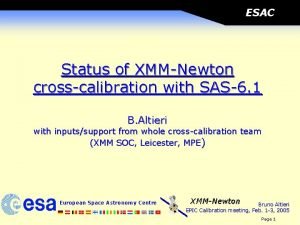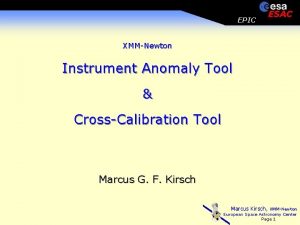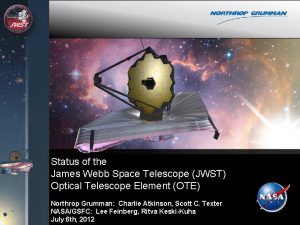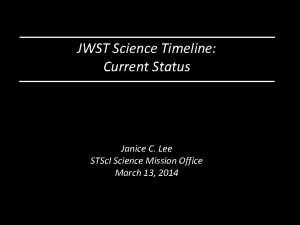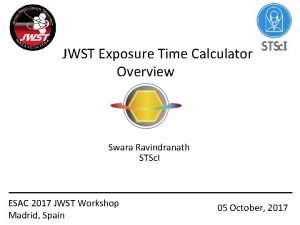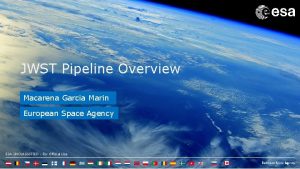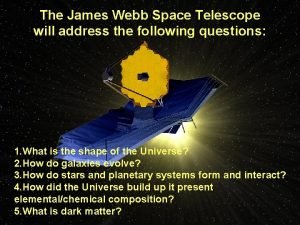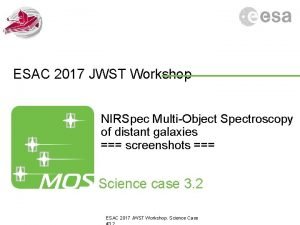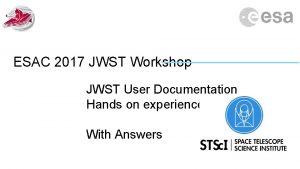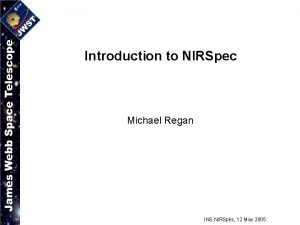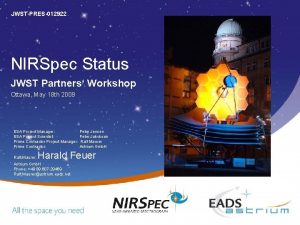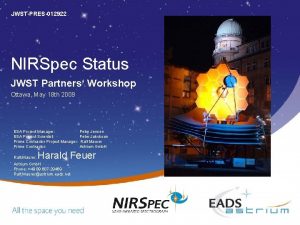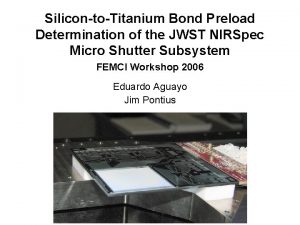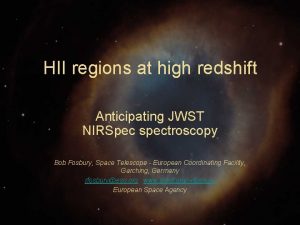ESAC 2017 JWST Workshop NIRSpec MSA Planning Tool











- Slides: 11

ESAC 2017 JWST Workshop NIRSpec MSA Planning Tool (MPT) Hands on experience Inspired by a JDOX page in preparation (L. Ubeda) and based on

Task Description Goal: Plan a NIRSpec MOS observation to capture high resolution spectra (R 2700) between 1. 7 and 3. 1 mm of the population of pre-main sequence stars in the star forming region NGC 346 of the SMC. Existing HST/ACS data are used to derive the input catalogue and the relative astrometry. There is no need of pre-imaging. Material Provided: • Star catalogue from Gouilermis et al. 2006 • Results of the Visibility tool • Exposure parameters and observing strategy Image of NGC 346 based on HST/ACS Go Program 10248 (PI. Nota) With the footprint of the MSA quadrant Field of View

Input Catalogue Star catalogue from Gouilermis et al. 2006 based on ACS data • ACS F 555 W (V) and F 814 W (I) photometry for > 99, 000 objects • Published catalogue has been reformatted and weights have been assigned: source type weight value upper main sequence UMS 10 pre-main sequence PMS 100 red giant branch RGB 40 other 1 • Astrometry accuracy: 10 mas

Apertire Position Angle Output of Visibility tool Note that for NIRSpec Aperture Position Angle=V 3 PA+138 deg

Exposure Parameter and Observing strateg • Requirement : spectra (R 2700) between 1. 7 and 3. 1 mm Configuration Grating/Filter = G 235 H/F 170 LP • • Readout Pattern: NRSIRS 2 RAPID (low readout noise mode that stores all detector reads) NGROUPS =65 (900 second exposure time) Integrations per exposure = 2 Autocal = none • Slit Setup = 3 shutter Slitlet with Nodding • NO Dither

Overview of the steps required 1. Import the catalogue 2. Define a list of primary candidates 3. Create a initial plan - analyze results 4. If time allows - create a second plan

1 - Importing the Catalogue Preliminary Steps 1. Start APT (version 25. 2. 3 for this hands on session) 2. Create a new JWST proposal • For this session there is no need to fill in Proposal Information or Target details 3. Create a new observation folder and select the MSA planning tool Import the catalogue 1. Select File format : white-space separated 2. Browse to the location of the file and upload it 3. Change the column type from “Ignore column” to “ Magnitude” in all magnitude columns 4. Insert the Catalogue Name ” NGC 346_full” 5. Select a column for Flux 6. Fill in the flux unit (Vegamag in this specific case) 7. Click on IMPORT

2 - Selecting the list of primary targets We are going to select all pre-main sequence starts (they have a weight of 100 in the catalogue) 1. Single click on the catalogue name 2. Insert the astrometry accuracy : 10 mas 3. Leave the Reference Position Type as “Catalog Median” 4. Set Pre-image availability to “Is already obtained” Create New candidate Set 1. Select the main catalogue NGC 346_full 2. Click on “New Candidate Set” 3. In the pop up window, name the new set as “PMS” 4. Add Filter “New Weight Filter” 5. Select Min=100 and Max=100 (we isolate all pre-main sequence stars in the catalogue” 6. Click on “make Candidate set”

3 - Create an initial plan Select “Planner” 1. Select Aperture PA =100 2. Select the Primary Candidate List: “PMS” 3. Filler List: none selected 4. Check the “Nod in Slitlet” checkbox 5. Leave Dither type to “No Dither” 6. • • Exposure Set up: G 235 H/F 170 LP NRSIRS 2 RAPID 65 groups 2 integrations 6. Set step size for the search Grid to 10” (5” is recommended given the density of objects. See Poster by E. Wislowski but takes more time) 7. Set number of MSA Configurations to 3 (3 different MSA configurations to increase the number of observed targets) 8. Name the plan as ”Plan_100_nod_step 10’ 9. Click Generate Plan (it will take about 3 -4 minutes)

3 - Analysis of the plan generated • 9 pointings (3 MSA configurations, each with 3 three point nod) • For each pointing between 58 and 62 targets are observed 1. Select the first 3 pointings (one nod-set) 2. Send targets to Aladin, check location of targets over a DSS image 3. Select all 9 pointings – check total number of stars in at least one exposure (173) 4. Select 1 pointing, c 1 e 2, click on “Show” 5. Analyze shutter diagram (green dot = primary target observed in the selected exposure, green cross = primary target observed in other exposures of the plan, black dot = contaminant, red shutter = failed open shutter)

4 - Create another plan 1. There are many possible optimizations and considerations: 2. You should experiment with different aperture position angles (the optimization of the MSA configuration depends on the orientation on the sky). Please note that specifying a restricted Aperture PA will impact scheduling. 3. You may also experiment with adding a large dither to bridge the detector gap (20 arcsec in dispersion direction). Our recommendation is to use Fixed Dithers to obtain the largest number of matched sources. See how many sources you are able to observe at BOTH locations. 4. If there are strong requirements on the flux accuracy the user should try to minimize slit losses and capture targets fairly centered in the slit. In order not to lose more than 25% of the flux compared to a well centered source, the user can change the source centering constraint from “Entire Shutter” to “Constrained” (this will reduce the number of sources somewhat). 5. Reducing the step of the search grid from 10” to 5” while increasing the calculation time, will most likely increase the number of targets observed in each pointing.


